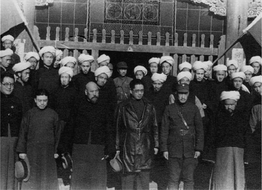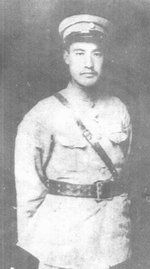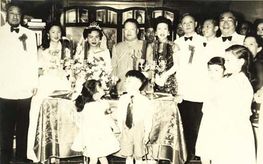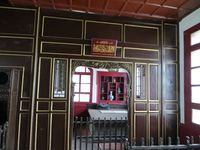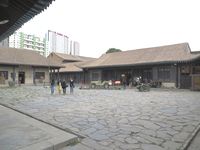ما بوفانج
| ما بوفنگ Ma Bufang | |
|---|---|
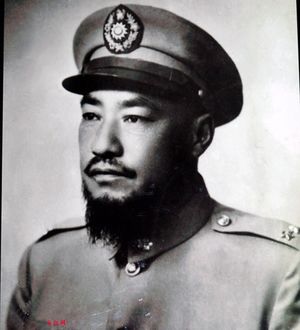
| |
| الفريق ما بوفنگ | |
| 1st Ambassador of the Republic of China to Saudi Arabia | |
| في المنصب August 1957 – June 1961 | |
| الرئيس | Chiang Kai-shek |
| خلفه | Bao Junjian |
| حاكم چينگهاي | |
| في المنصب 5 Mar 1938 – Sep 1949 | |
| سبقه | ما لين (أمير حرب) |
| خلفه | Zhao Shoushan (Chao Shou-shan) |
| تفاصيل شخصية | |
| وُلِد | 1903 لينشيا، گانسو |
| توفي | 1975 السعودية |
| القومية | شعب الهوي |
| الحزب | كومنتانگ |
| الجامعة الأم | فيلق تدريب الضباط في چنگهاي[1] |
| الدين | مسلم سني يتبع الطريقة الصوفية الخوفية |
| الخدمة العسكرية | |
| الكنية | ملك چنگهاي |
| الولاء | |
| سنوات الخدمة | 1928-1949 |
| الرتبة | جنرال |
| الوحدة | جيش ننگهاي |
| قاد | Chairman of Qinghai Province, Commander-in-Chief of 40th Army Group |
| المعارك/الحروب | الحرب التبتية الصينية، المسيرة الطويلة، الحرب الصينية اليابانية الثانية، الحرب الأهلية الصينية، تمرد إلي، اخضاع الكومنتانگ لچنگهاي |
| الأوسمة | Order of Precious Tripod |
- هذا هو اسم صيني; لقب العائلة هو ما.
ما بوفانگ Ma Bufang (1903–1975) (الصينية المبسطة: 马步芳; الصينية التقليدية: 馬步芳; پنين: Mǎ Bùfāng; ويد–گايلز: Ma Pufang)، هو أمير حرب مسلم شهير في الصين أثناء فترة تايوان، كان الحاكم العسكري لمقاطعة چينگهاي.[2][3] وكان برتبة فريق.[4] ويـُنظر إلى "ما" كمصلح ومجدد أثناء حكمه چينگهاي.[5]
بدأ الجنرال ما مشروع تصنيع حكومي، يخلق يشكل مباشر مشاريع تعليمية وطبية وزراعية وللصرف الصحي بتمويل وإشراف حكومي.
حياته
Ma Bufang and his older brother Ma Buqing (1901–1977) were born in Monigou Township (漠泥溝鄉)[6] in what is today Linxia County, 35 كيلومتر (22 mi) west of Linxia City.[7] Their father Ma Qi (馬麒) formed the Ninghai Army in Qinghai in 1915, and received civilian and military posts from the Beiyang Government in Beijing confirming his military and civilian authority there.
| جزء من سلسلة عن الإسلام في الصين |
|---|
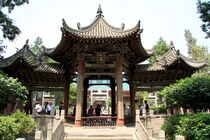 |
|
|
His older brother Ma Buqing received a classical Chinese education, while Ma Bufang received education in Islam.[8] Ma Qi originally had Ma Bufang study to become an imam while his older brother Ma Buqing was educated in the military. Ma Bufang studied until he was nineteen and then pursued a military career like his brother.[9] Ma Bufang controlled the Great Dongguan Mosque.[9] Ma was a graduate of the Officers' Training Corps of Qinghai.[1]
Ma Bufang sided with Feng Yuxiang's Guominjun until the Central Plains War, when he switched to the winning side of Chiang Kai-shek. Ma Qi died in 1931 and his power was assumed by his brother Ma Lin (馬麟), who was appointed governor of Qinghai.
الحرب على التبت، القزخ، والشيوعيين
ارتقاؤه لمنصب حاكم
General Ma Lin held the position of civil Governor, while Ma Bufang was military Governor. They feuded with, and disliked each other. Ma Bufang was not admired by people as much as his uncle Ma Lin, whom the people adored.[10]
In 1936, under the order of Chiang Kai-shek, and with the help of Ma Zhongying's remnant force in Gansu, and Ma Hongkui's and Ma Hongbin's force from Ningxia, Ma Bufang and his brother Ma Buqing played an important role in annihilating Zhang Guotao's 21,800 strong force that crossed the Yellow River in an attempt to expand the Communist base. In 1937, Ma Bufang rose with the help of the Kuomintang and forced his uncle Ma Lin to concede his position. At that point Ma Bufang became governor of Qinghai, with military and civilian powers, and remained in that position until the Communist victory in 1949. During Ma Bufang's rise to power, he along with Ma Buqing and cousins Ma Hongkui and Ma Hongbin, were instrumental in helping another cousin, Ma Zhongying, to prevail in Gansu. They did not want Ma Zhongying to compete with them on their own turf, so they encouraged and supported Ma Zhongying in developing his own power base in other regions such as Gansu and Xinjiang. Ma Bufang defeated Ma Zhongying in a battle in Gansu, and drove him into Xinjiang.
In 1936, Ma Bufang was appointed commander of the newly organized 2nd army.[11]
Because Ma Bufang did not want the 14th Dalai Lama to succeed his predecessor, he stationed his men in such a way that the Dalai Lama was effectively under house arrest, saying this was needed for "protection", and refusing to permit him to leave for Tibet.[12] He did all he could to delay the movement of the Dalai Lama from Qinghai to Tibet by demanding 100,000 Chinese silver dollars.[13][14][15]
Even though his uncle Ma Lin was officially governor of Qinghai, Ma Bufang held de facto military power in the province and foreigners acknowledged this.[16] While his uncle Ma Lin was governor of Qinghai, Ma Bufang was pacification commissioner of Gansu.[17] In 1936, during Autumn, Ma Bufang made his move to expel his uncle from power and to replace him.[18] Ma Bufang made Ma Lin's position untenable and unbearable until he resigned from power by making the Hajj to Mecca.[19] Ma Lin's next position was to be part of the National Government Committee. In an interview Ma Lin was described as having: "high admiration and unwavering loyalty to Chiang Kai-shek".[20]
The Qing dynasty had granted his family a yellow standard which had his family name "Ma" on it. Ma Bufang continued to use this standard in battle and, as of 1936, he had 30,000 Muslim cavalrymen in his army.[21]
مذبحة القزخ
War against Tibet and Ngoloks
Ma Bufang had a conflicted relationship with the Tibetan population of Qinghai. Some Tibetan Buddhists served in his army while others were crushed and killed by it.
In 1932, Ma Bufang's Muslim troops, and the Han Chinese general Liu Wenhui, defeated the 13th Dalai Lama's Tibetan armies when Tibet tried to invade Qinghai province. Ma Bufang overran the Tibetan armies and recaptured several counties in Xikang province. Shiqu, Dengke, and other counties were seized from the Tibetans[22][23][24] who were pushed back to the other side of the Jinsha River.[25][26] Ma and Liu warned Tibetan officials not to cross the Jinsha River again.[27] A truce was signed ending the fighting.[28][29]
The reputation of the Muslim forces of Ma Bufang was boosted by the war and victory against the Tibetan army.[30] The stature of Ma Biao rose over his role in the war and later in 1937 his battles against the Japanese propelled him to fame nationwide in China. The control of China over the border area of Kham and Yushu with Tibet was guarded by the Qinghai army. Chinese Muslim run schools used their victory in the war against Tibet to show how they defended the integrity of China's territory as it was put in danger since the Japanese invasion.[31]
The Kuomintang Republic of China government supported Ma Bufang when he launched seven extermination expeditions into Golog, eliminating thousands of Ngolok tribesmen.[32] Some Tibetans counted the number of times he attacked, remembering the seventh attack which made life impossible for them.[33] Ma was highly anti-communist, and he and his army wiped out many Ngolok tribal Tibetans in the northeast and eastern Qinghai, and also destroyed Tibetan Buddhist Temples.[34][35][36]
The Kunlun Middle School was established by Ma Bufang, and it recruited Tibetan students, who were subjected to a harsh military life. Ma wanted to use them as translators as he expanded his military domain over land inhabited by Tibetans.[37] As Ma Bufang defeated more Tibetans, he also drafted them into his army.
Ma Bufang attacked and demolished a Tibetan Buddhist monastery in Rebgong in 1939, one of the oldest in Amdo.[38] Ma Bufang sent his army to destroy and loot the Tsanggar Monastery in 1941; his forces expelled the monks. It was not until the Communists took power that the Monastery could be rebuilt; the monks returned in 1953.[39] Many of the monasteries attacked by Ma Bufang were associated with the Ngoloks.
Tibetan tribals in southern Qinghai revolted due to taxation between 1939 and 1941, but they were crushed by "suppression campaigns" and massacred by Ma Bufang which caused a major influx of Tibetan refugees into Tibet from Qinghai.[40]
A former Tibetan Khampa soldier named Aten, who battled Ma Bufang's forces, provided an account of a battle. He described the Chinese Muslims as "fierce". After he and his troops were ambushed by 2,000 of Ma Bufang's Chinese Muslim cavalry, he was left with bullet wounds and he "had no illusions as to the fate of most of our group", most of whom were wiped out.[41][42] Aten also asserted that "the Tibetan province of Amdo", was "occupied" by Ma Bufang.[43]
الحرب الصينية اليابانية الثانية
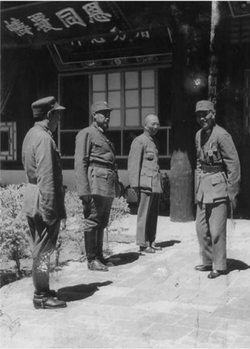
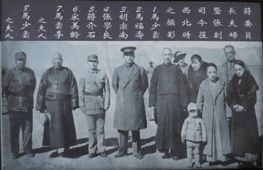
Ma Bufang called for peace and tolerance between ethnicities.[44]
The soldiers in Ma Bufang's cavalry forces belonged to a wide range of ethnicities. Hui, Mongols, Tibetans, and Han Chinese all served in Ma Bufang's cavalry.[45] Ma Bufang's ethnic tolerance in theory ensured that recruits could escape ethnic divergence in his armies.
In 1937 and 1938, the Japanese attempted to approach Ma Bufang and were ignored.[46]
Ma Bufang's soldiers were designated as the 82nd Army during the war against Japan.[47][48][49][50][51]
In 1937, When the Japanese attack at the Battle of Beiping–Tianjin began the Chinese government was notified by Muslim General Ma Bufang of the Ma clique that he was prepared to bring the fight to the Japanese in a telegram message.[52] Immediately after the Marco Polo Bridge Incident, he arranged for a cavalry division, under Muslim General Ma Biao, to be sent east to battle the Japanese.[53] Ma Buqing and Ma Bufang discussed the battle plans against the Japanese over the telephone with Chiang Kai-shek. The top crack elite cavalry of Ma Bufang was sent against Japan. Ethnic Turkic Salar Muslims made up the majority of the first cavalry division which Ma Bufang sent.[54]
Because of fierce resistance by Ma Hongkui and Ma Bufang's Muslim cavalry, the Japanese were never able to reach and capture Lanzhou during the war.[55] Ma Bufang also obstructed Japanese agents trying to contact the Tibetans and was called an "adversary" by a Japanese agent.[56]
Ma became governor of Qinghai when he expelled his uncle Ma Lin from power in 1938.[57] He commanded a group army. He was appointed because of his anti-Japanese inclinations.[1][58]
Under orders from the Kuomintang government of Chiang Kaishek, Ma Bufang repaired Yushu Batang Airport to prevent Tibetan separatists from seeking independence.[بحاجة لمصدر] Chiang also ordered Ma Bufang to put his Muslim soldiers on alert for an invasion of Tibet in 1942.[59] Ma Bufang complied, and moved several thousand troops to the border with Tibet.[60] Chiang also threatened the Tibetans with bombing if they did not comply. Ma Bufang attacked the Tibetan Buddhist Tsang monastery in 1941.[61] He also constantly attacked the Labrang Monastery.[62]
Ma Bufang's army battled extensively in bloody battles against the Japanese in Henan province. Ma Bufang sent his army, under the command of his relative General Ma Biao, to fight the Japanese in Henan. The Qinghai Chinese, Salar, Chinese Muslim, Dongxiang, and Tibetan troops Ma Bufang sent fought to the death against the Imperial Japanese Army, or committed suicide refusing to be taken prisoner, when cornered by the enemy. When they defeated the Japanese, the Muslim troops slaughtered all of them except for a few prisoners sent back to Qinghai to prove that they had been victorious. In September 1940, when the Japanese launched an offensive against the Muslim Qinghai troops, the Muslims ambushed them and killed so many of them that they were forced to retreat. The Japanese could not even pick up their dead; instead, they cut an arm from their corpses for cremation to send back to Japan. The Japanese did not attempt to make a similar offensive again.[63] Ma Biao was the eldest son of Ma Haiqing, who was the sixth younger brother of Ma Haiyan, Ma Bufang's grandfather.[64]
During the war against Japan, Ma Bufang commanded the 82nd Army.[65]
Xining was subjected to aerial bombardment by Japanese warplanes in 1941 during the Second-Sino Japanese War. The bombing spurred all ethnicities in Qinghai, including the local Qinghai Mongols and Qinghai Tibetans, against the Japanese.[66][67] The Salar Muslim General Han Youwen directed the defense of the city of Xining during air raids by Japanese planes. Han survived an aerial bombardment by Japanese planes in Xining while he was being directed via telephone from Ma Bufang, who hid in an air raid shelter in a military barracks. The bombing resulted in human flesh splattering a Blue Sky with a White Sun flag and Han being buried in rubble. Han Youwen was dragged out of the rubble while bleeding and he managed to grab a machine gun while he was limping and fired back at the Japanese warplanes and cursed the Japanese as dogs in his native Salar language.[68][69]
Ma Bukang and Ma Bufang were having a discussion on Ma Biao when Japanese warplanes bombed Xining.[70]
In 1942, Generalissimo Chiang Kai-shek, head of the Chinese government, toured Northwestern China in Xinjiang, Gansu, Ningxia, Shaanxi, and Qinghai, where he met both Ma Buqing and Ma Bufang. It was reported around this time that Ma had 50,000 elite soldiers in his army.[71]
Ma Bufang supported the Chinese nationalist imam Hu Songshan.[72]
الحرب الأهلية الصينية
Ma Bufang was elected to the Sixth Central Committee of the Kuomintang in 1945.
The Kuomintang Chinese government ordered Ma Bufang to march his troops into Xinjiang several times to intimidate the pro-Soviet Governor Sheng Shicai. This helped to provide protection for Chinese settling in Xinjiang.[73] Ma Bufang was sent with his Muslim Cavalry to Urumqi by the Kuomintang in 1945 during the Ili Rebellion to protect it from the Uyghur army from Hi.[74][75][76][77]
Ma Bufang relocated Genghis Khan's shrine from Yulin to Xining in 1949.[78][79] On April 7, 1949 Ma Bufang and Ma Hongkui announced jointly that they would continue to fight the Communists, and would not make an accord with them.[80] Fighting continued as the Communists advanced.[81] Ma was made Chief of all Military and Political affairs of the Northwest by the Kuomintang.[82]
The Panchen Lama, who was exiled from Tibet by the Dalai Lama's government, wanted to seek revenge by leading an army against Tibet in September 1949 and asked for help from Ma Bufang.[83] Ma Bufang patronized the Panchen Lama, and the Lamaist Red Sect against the Dalai Lama. Qinghai served as a "sanctuary" for Red Sect members; Ma Bufang allowed Kumbum Monastery to be totally self-governed by the Panchen Lama.[84]
General Ma Bufang was appointed Supreme Commander in Chief of the entire region of northwestern China by the government, described by TIME magazine as "13 times as big as Texas", containing "14 million people" "one-third Han Chinese, one-third Moslem Chinese, and the remainder Tibetans, Turkis, Mongolians, Kazaks". He entered Lanzhou in a Buick with his troops, seizing buildings and setting up camps.[85] Ma Bufang also had to battle against forty Soviet warplanes sent by Joseph Stalin against his forces.[86]
Generals Hu Zongnan and Ma Bufang led five corps to defeat General Peng's army near Baoji. They killed 15,000 members of the People's Liberation Army (PLA).[87]
في أغسطس 1949، سافر ما بوفانگ بالطائرة إلى حكومة الكومنتانگ في كانتون طلباً لإمدادات بالإسقاط الجوي، بينما تولى ابنه ما جييوان قيادة قوات الكومنتانگ في لانژو والذي أخبر الصحفيين أنه سوف يدافع عن المدينة. إلا أن الحكومة رفضت طلبه، وطار ما عائداً إلى لانژو، ثم تخلى عنها، منسحباً بالشاحنات إلى شيننگ.[88] ثم هزم جيش التحرير الشعبي الشيوعي الصيني، بقيادة الجنرال پنگ دىهواي، جيش ما واحتل لانژو، عاصمة گانسو. طـُرِد ما من شيننگ و فر إلى تشونگچينگ ثم هونگ كونگ. وكان معه 50,000 دولار نقداً.[89] وأثناء إقامته في شقة في هونگ كونگ، أعرب عن نيته الفرار إلى مكة.[90] وفي أكتوبر، ناشده تشيانگ كاي-شك أن يعود إلى الشمال الغربي لمقاومة جيش التحرير الشعبي، إلا أنه سافر إلى مكة مع أكثر من 200 قريب وتابع، لأداء فريضة الحج.[91]
ما بوفانگ، وأفراد عائلته مثل ابنه ما جييوان، وابن عمه ما بوكانگ، وابن أخيه ما تشنگشيانگ، فروا إلى السعودية؛ إلا أنهم بعد عام واحد، انتقل ما بوفانگ و ما بوكانگ إلى القاهرة، مصر، بينما انتقل ابنه ما جييوان، مع عشر جنرالات، إلى تايوان.[92][93]
أعلن الجنرال ما بوفانگ بداية التمرد الإسلامي للكومنتانگ في الصين (1950-1958)، في 9 يناير 1950، حين كان في القاهرة، مصر، قائلاً أن المسلمين الصينيين لن يستسلموا للشيوعية وسوف يخوضوا حرب عصابات ضد الشيوعيين.[94][95] قواته العسكرية السابقة، ومعظمها كان من المسلمين، واصلت لعب دوراً رئيسياً في التمرد.[96]
وفي 1950، انتقل ما إلى القاهرة، وذلك لطلب العون من الدول العربية.[97][98] عمل ما ممثلاً للكومنتانگ في مصر.[99]
مبعوثاً إلى مصر
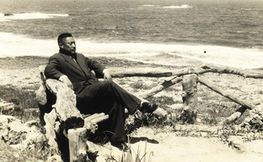
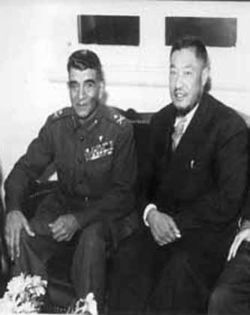
In early 1950, Ma Bufang flew to Mecca, Saudi Arabia with her family and more than 200 followers in the name of Hajj . In May 1950, Ma and his party took a ship across the Red Sea to Cairo . Accompanied by the charge d'affaires Wang Jiaxiang , they met with the King of Egypt and were promised to live in Egypt. After that, they moved to the Mardi residential area on the outskirts of Cairo and lived at No. 33 Mardi.
In 1957, due to the establishment of diplomatic relations between Egypt and the People's Republic of China , Ma Bufang moved to Saudi Arabia. In August of the same year, Chiang Kai-shek appointed Ma Bufang as the ambassador of the Republic of China to Saudi Arabia . During his tenure, he never went to Taiwan to report on his duties. In August 1961, the scandal of forcing his niece Ma Yuelan to become a concubine was exposed by Song Xuanquan, the diplomat of the Republic of China in Saudi Arabia . He was dismissed from his post and recalled to Taiwan to face justice. However, Ma Bufang refused to return to Taiwan and was naturalized in Saudi Arabia .
In July 1975, Ma Bufang died of illness in Saudi Arabia.
سفير إلى السعودية
In 1957, after the establishment of diplomatic relations between Egypt and the People's Republic of China, Ma was transferred by Taipei to serve as the ROC ambassador to Saudi Arabia.[100] Ma served in this post for four years; he never returned to Taiwan. He remained in Saudi Arabia until his death in 1975 at age 72. He had one son, Ma Jiyuan (馬繼援), who served as a divisional commander in Ma Bufang's army.
موقفه تجاه استقلال تركستان الشرقية
While serving as ambassador, in response to a request by Abdul Ahad Hamed, a former Uyghur Mufti living in Saudi Arabia, for accommodations to be granted to Uyghurs who held Republic of China passports, living outside China, Ma Bufang sent the following letter which rejected this request and rejected his usage of the term "East Turkestan", upheld the official position of the Republic of China that Xinjiang was a part of China and that it did not recognize the East Turkestan Independence Movement.[101]
Dear Brother,
With all due respect to your previous position in the Government of Sinkiang and to the confidence placed in you by His Excellency the President of the Republic of China, I hope that you will refrain from using expressions which should not be used by one who occupied the position of a mufti. We are all serving our beloved country trying to do our best for our countrymen. I also hope that you will refrain from using the expression "The Turkestani Nation" which was the creation of one Abdul Qayyum Khan while he was living in Germany. We are working for the welfare of the true people of Sinkiang not for the Turkestanis living outside Sinkiang or the followers of Abdul Qayyum Khan.
Best regards,
Ambassador of Nationalist China in Saudi Arabia[102]
قصره
قصر ما بوفانگ في Xining, Qinghai was where Ma and his family lived from 1943 to 1949. In 1938 Ma Bufang built a residence for his concubine called East mansion.[103] Ma Bufang's headquarters was converted into the provincial museum by the Communists, until a new one was built. It currently contains the "Qinghai Cultural Relics and Archaeology Institute" collection.[104]
ضباط سابقون
Ma Bufang's former chief of staff was Ma Wending, who defected to the communists and became vice-chairman of the Standing Committee of the Qinghai Provincial People's Congress.[105]
Another officer who served under Ma Bufang, the Salar General Han Youwen, also defected to the Communists and joined the People's Liberation Army.
Ma Bufang had another chief of staff in his North-West Command, Ma Ji. Ma Ji's son Ma Wenying later became a well known tailor.[106]
سياساته
العسكرية
Ma Bufang recruited many Salar officers, such as Han Yimu and General Han Youwen into his army; most came from Xunhua County.
Ma Bufang's regime centered on the support of "fanatically disciplined and obedient Chinese Muslims". After he took over as Governor, he turned to civilian governing. His son was handed Ma Bufang's former role as authority over the army.[107]
القومية
Ma Bufang presented himself as a Chinese nationalist to the people of China, fighting against British Imperialism, to deflect criticism by opponents that his government was feudal and oppressed minorities like Tibetans and Buddhist Mongols. He presented himself as a Chinese nationalist to his advantage to keep himself in power as noted by the author Erden.[108][109] The Kuomintang party was officially anti-feudal, and the Kuomintang itself claimed to be a revolutionary party of the people, so being accused of feudalism was a serious insult. Chiang Kai-shek, leader of the Kuomintang, spoke out publicly against feudalism and feudal warlords.[110] Ma Bufang was forced to defend himself against the accusations, and stated to the news media that his army was a part of the "National army, people's power".[111]
الاشتراكية والتصنيع
Ma Bufang was described as a socialist by American journalist John Roderick and "friendly" compared to the other Ma Clique warlords.[112] Ma Bufang was reported to be good humoured and jovial in contrast to the brutal reign of Ma Hongkui.[113]
Most of eastern China was ravaged by the Second Sino-Japanese War. In contrast, during the Chinese Civil war Qinghai was relatively untouched.
An American scholar, A. Doak Barnett, praised Ma Bufang's government as: "one of the most efficient in China, and one of the most energetic. While most of China is bogged down, almost inevitably, by Civil War, Chinghai is attempting to carry our small-scale, but nevertheless ambitious, development and reconstruction schemes on its own initiative".[114]
General Ma started a state run and controlled industrialization project, directly creating educational, medical, agricultural, and sanitation projects, run or assisted by the state. The state provided money for food and uniforms in all schools, state run or private. Roads and a theater were constructed. The state controlled the press; no freedom was allowed for independent journalists. His regime was dictatorial in its political system. Barnett admitted that the regime had "sterm authoritarianism" and "little room for personal freedom".[115]
In 1947 the United States sold Ma Bufang a piped water (sewage) system which was installed in Xining.[116]
Like all the other Kuomintang members, Ma Bufang was anti-Communist.
Ma was regarded as a "modernizer" and "reformer" during his rule over Qinghai.[117]
البيئة والبنية التحتية
Ma enforced a strict reforestation program to help the environment. Villagers were required to meet a quota for tree planting after being supplied with saplings and instructions; cutting down a tree without permission led to execution. Millions of trees were planted in Qinghai during his rule, and he built an irrigation system in addition to roads. Around 1.5 million people lived in Qinghai under Ma Bufang.[85] He was obsessed with preventing soil erosion and tree planting, saying: "The salvation of our desert was in the tree". He had "education teams" teach the entire population about the role of trees in protecting the environment.[118]
التعليم وحقوق المرأة
Ma Bufang also promoted education. He made businessmen methodically clean up Xining, the capital of Qinghai, by serving as insect exterminators, killing flies, and neatly disposing of them.[119]
Ma Bufang and his wife built a school for Muslim girls in Linxia which provided a modern secular education.[120]
راعي الفنون
Ma Bufang sent the Chinese artist Zhang Daqian to Sku'bum to seek helpers to analyze and copy Dunhuang Buddhist art.[121] Ma Bufang patronized the folk songwriter Wang Luobin, who wrote the famous folk song "In That Place Wholly Faraway" in Qinghai while shooting a film at Ma's invitation. Ma Bufang later rescued Wang Luobin from prison and employed him on his staff.[122] Wang composed the "War Horse Song" for the cavalry division Ma Bufang sent to fight the Japanese invaders as well as the "March of the Chinese Muslims".[123][استشهاد ناقص]
رعاية الأقليات
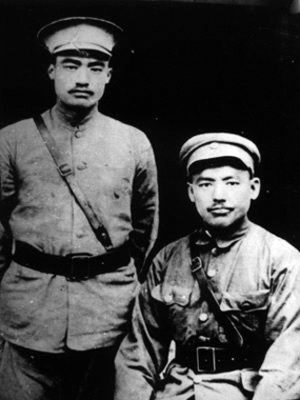
Author Kevin Stuart claimed that the Mongour were reported to have been abused by KMT officials under Ma Bufang. However, there is no evidence to support these claims.[124][125]
Ma cooperated with the Panchen Lama against the Dalai Lama's regime in Tibet. The Panchen Lama stayed in Qinghai. Ma tried to persuade him to come with the Kuomintang government to Taiwan when the Communist victory was imminent, but the Panchen Lama decided to defect to the Communists instead. The Panchen Lama, unlike the Dalai Lama, sought to exert control in decision making.[126][127] In addition, the Kuomintang expanded into the Lhasa regime of the Dalai Lama.[128]
Closer to the Communist takeover, Ma Bufang tried to rally Tibetan and Mongol militia at Kokonuur Lake. A Mongol official, Wang Benba, derailed the attempt, urging them not to fight, saying that Communist victory was inevitable.[129]
تصيين وأسلمة التبت
Tibetan independence groups allege and accuse Ma Bufang of carrying out Sinicization policies in Tibetan areas: he is said to have forced Tibetans to intermarry, and to change their religious beliefs. He also spread and popularized holidays such as the Chinese New Year.[130]
Since Qinghai (Amdo) was under Ma's rule, the 14th Dalai Lama and his family spoke Chinese as their native language, not knowing Tibetan until 1939 when they relocated their home to Lhasa.[131]
Ma Bufang eliminated slavery and lordship among the Mongols and Tibetans. From the book The Mongols at China's Edge: History and the Politics of National Unity, the author, Uradyn Erden Bulag wrote: "In the past, the Mongols and Tibetans were divided as lords and slaves, but the two Chairmen [Ma Qi and Ma Bufang], insisting on the principle of equality of all nationalities in our country, corrected the absurdity and astutely reformed it."[132]
الإسلام
The new Yihewani (Ikhwan) sect was patronized and backed by Ma Lin and Ma Bufang to help modernize society, education, and reform old traditions. Ma Bufang kept religious affairs and clerics separate from state and civil affairs; religion was only concerned with education, morality, and other non-administrative matters.[133]
The Yihewani sect was modernist, identifying strongly with Chinese culture and politics, whereas the Salafi Muslims stressed a non-political, and, what they termed an "original" form of Islam. In 1937, when the Salafi formally split with the Yihewani Muslim Brotherhood, Ma Bufang persecuted them as "heterodox" and "foreign". The Salafis were not allowed to move or to worship openly.[134] General Ma effectively suppressed all non-Yihewani groups, including the traditional Sunni Gedimu, the oldest sect of Islam in China, by enforcing Yihewani Imams on them. However, when the Communist party took over, the Gedimu used the Communist party's rules on freedom of religion to ward off the Yihewani practices and imams.[135]
In contrast to his treatment of Salafis, General Ma allowed polytheists to worship openly, and Christian missionaries to station themselves in Qinghai. General Ma, and other high-ranking Muslim Generals, even attended the Kokonuur Lake Ceremony where the God of the Lake was worshipped. During the ritual, the Chinese national anthem was sung. Participants bowed to a portrait of Kuomintang Party founder Dr. Sun Zhongshan, and to the God of the Lake, and offerings were given to him by the participants, which included Muslims.[136] Ma Bufang invited Kazakh Muslims to attend the ceremony honoring the God.[137] He received audiences of Christian missionaries, who sometimes gave him the Gospel.[138][139] His son Ma Jiyuan received a silver cup from Christian missionaries.[140]
مناهضة الصوفية/الوهابية

عمله
- 1928 ضابط القيادة العامة للتقسيم التاسع الجديد
- 1932 ضابط القيادة العامة للقوات الثانية الجديدة
- 1938 - 1949 الحاكم العسكري لمقاطعة چينگهاي
- 1938 - 1941 ضابط القيادة العامة للقوات LXXXII
- 1943 - 1945 القائد العام لمجموعة الجيش الأربعين
He commanded the New 9th Division, New 2nd Army, and the 82nd Army.[141] Another one of his positions was vice-commander of the 77th Brigade of the 26th Division.[142][143]
انظر أيضا
المصادر
- ^ أ ب ت Robert L. Jarman (2001). China Political Reports 1911-1960: 1942-1945. Archive Editions. p. 311. ISBN 1852079304. Retrieved 2010-06-28.
- ^ Zedong Mao, Michael Y. M. Kau, John K. Leung (1986). Michael Y. M. Kau, John K. Leung (ed.). The Writings of Mao Zedong, 1949-1976: September 1945 - December 1955. M.E. Sharpe. p. 34. ISBN 0873323912. Retrieved 2010-6-28.
{{cite book}}: Check date values in:|accessdate=(help)CS1 maint: multiple names: authors list (link) - ^ Piper Rae Gaubatz (1996). Beyond the Great Wall: urban form and transformation on the Chinese frontiers. Stanford University Press. p. 36. ISBN 0804723990. Retrieved 2010-6-28.
{{cite book}}: Check date values in:|accessdate=(help) - ^ Paul Preston, Michael Partridge, Antony Best. British documents on foreign affairs: reports and papers from the Foreign Office confidential print. From 1946 through 1950. Asia, Volume 1. University Publications of America. p. 37. ISBN 155655768X. Retrieved 2010-06-28.
{{cite book}}: CS1 maint: multiple names: authors list (link) - ^ Graham Hutchings (2003). Modern China: a guide to a century of change (illustrated, reprint ed.). Harvard University Press. p. 351. ISBN 0674012402. Retrieved 2010-6-28.
{{cite book}}: Check date values in:|accessdate=(help) - ^ "临夏旅游" (Linxia Tourism), published by Linxia Hui Autonomous Prefecture Tourist Board, 2003. 146 pages. No ISBN. Pages 68-69.
- ^ Met, Y. P. (1941). "The STRONGHOLD OF MUSLIM CHINA". The Muslim World. 31 (2): 178–184. doi:10.1111/j.1478-1913.1941.tb00924.x.
- ^ Stéphane A. Dudoignon; Hisao Komatsu; Yasushi Kosugi (2006). Intellectuals in the modern Islamic world: transmission, transformation, communication. Taylor & Francis. p. 255. ISBN 978-0-415-36835-3. Retrieved 2010-06-28.
- ^ أ ب Stéphane A. Dudoignon (2004). Devout societies vs. impious states?: transmitting Islamic learning in Russia, Central Asia and China, through the twentieth century : proceedings of an international colloquium held in the Carré des Sciences, French Ministry of Research, Paris, November 12–13, 2001. Schwarz. p. 68. ISBN 3-87997-314-8. Retrieved 2010-06-28.
- ^ Violet Olivia Rutley Cressy-Marcks (1942). Journey into China. E.P. Dutton & co., inc. p. 292. Retrieved 2010-11-28.
- ^ The China monthly review, Volumes 78-79. .W. Powell. 1936. p. 367. Retrieved 2010-06-28.
- ^ American Asiatic Association (1940). Asia: journal of the American Asiatic Association, Volume 40. Asia Pub. Co. p. 26. Retrieved 2011-05-08.
- ^ Melvyn C. Goldstein (1991). A history of modern Tibet, 1913-1951: the demise of the Lamaist state. University of California Press. p. 321. ISBN 0-520-07590-0. Retrieved 2010-06-28.
- ^ Committee of 100 for Tibet & the Dalai Lama Foundation, Loyola University of Chicago. Museum of Art (2006). The Missing Peace: Artists and the Dalai Lama. Earth Aware. p. 5. ISBN 1-932771-92-1. Retrieved 2011-04-09.
{{cite book}}: CS1 maint: numeric names: authors list (link) - ^ Parshotam Mehra (2004). From conflict to conciliation: Tibetan polity revisited : a brief historical conspectus of the Dalai Lama-Panchen Lama Standoff, ca. 1904-1989. Otto Harrassowitz Verlag. p. 84. ISBN 3-447-04914-6. Retrieved 2011-04-09.
- ^ Royal Central Asian Society; Central Asian Society (1934). Journal of the Royal Central Asian Society, Volume 21. Royal Central Asian Society. p. 25. Retrieved 2010-06-28.
- ^ Laurence A. Schneider (1971). Ku Chieh-kang and China's new history: nationalism and the quest for alternative traditions. University of California Press. p. 290. ISBN 0-520-01804-4. Retrieved 2010-06-28.
ma pu-fang japanese.
- ^ American Asiatic Association (1940). Asia: journal of the American Asiatic Association, Volume 40. Asia Pub. Co. p. 660. Retrieved 2011-05-08.
- ^ Dean King (2010). Unbound: A True Story of War, Love, and Survival (illustrated ed.). Hachette Digital, Inc. ISBN 978-0-316-16708-6. Retrieved 2010-06-28.
- ^ Hartford Seminary Foundation (1941). The Moslem World, Volumes 31-34. Hartford Seminary Foundation. p. 183. Retrieved 2011-05-08.
- ^ Dean King (2010). Unbound: A True Story of War, Love, and Survival (illustrated ed.). Hachette Digital, Inc. ISBN 978-0-316-16708-6. Retrieved 2010-06-28.
- ^ Jiawei Wang, Nimajianzan (1997). The historical status of China's Tibet. 五洲传播出版社. p. 150. ISBN 7-80113-304-8. Retrieved 2010-06-28.
- ^ Hanzhang Ya; Ya Hanzhang (1991). The biographies of the Dalai Lamas. Foreign Languages Press. pp. 352, 355. ISBN 0-8351-2266-2. Retrieved 2010-06-28.
- ^ B. R. Deepak (2005). India & China, 1904-2004: a century of peace and conflict. Manak Publications. p. 82. ISBN 81-7827-112-5. Retrieved 2010-06-28.
- ^ International Association for Tibetan Studies. Seminar, Lawrence Epstein (2002). Khams pa histories: visions of people, place and authority: PIATS 2000, Tibetan studies, proceedings of the 9th Seminar of the International Association for Tibetan Studies, Leiden 2000. BRILL. p. 66. ISBN 90-04-12423-3. Retrieved 2010-06-28.
- ^ Gray Tuttle (2005). Tibetan Buddhists in the making of modern China. Columbia University Press. p. 172. ISBN 0-231-13446-0. Retrieved 2010-06-28.
- ^ Xiaoyuan Liu (2004). Frontier passages: ethnopolitics and the rise of Chinese communism, 1921-1945. Stanford University Press. p. 89. ISBN 0-8047-4960-4. Retrieved 2010-06-28.
- ^ Oriental Society of Australia (2000). The Journal of the Oriental Society of Australia, Volumes 31-34. Oriental Society of Australia. pp. 35, 37. Retrieved 2010-06-28.
- ^ Gervers, Michael; Schlepp, Wayne (1998). Historical themes and current change in Central and Inner Asia: papers presented at the Central and Inner Asian Seminar, University of Toronto, April 25–26, 1997, Volume 1997. Joint Centre for Asia Pacific Studies. pp. 73, 74, 76. ISBN 1-895296-34-X. Retrieved 2010-06-28.
- ^ Haas, William Brent (2016-03-23). Qinghai Across Frontiers: State- and Nation-Building under the Ma Family, 1911-1949 (PDF) (PhD thesis). UNIVERSITY OF CALIFORNIA, SAN DIEGO. p. 91.
- ^ Haas, William Brent (2016-03-23). Qinghai Across Frontiers: State- and Nation-Building under the Ma Family, 1911-1949 (PDF) (PhD thesis). UNIVERSITY OF CALIFORNIA, SAN DIEGO. p. 92.
- ^ Uradyn Erden Bulag (2002). Dilemmas The Mongols at China's edge: history and the politics of national unity. Rowman & Littlefield. p. 54. ISBN 0-7425-1144-8. Retrieved 2010-06-28.
- ^ Chung-kuo fu li hui; Zhongguo fu li hui (1961). China reconstructs, Volume 10. China Welfare Institute. p. 16. Retrieved 2010-06-28.
- ^ David S. G. Goodman (2004). China's campaign to "Open up the West": national, provincial, and local perspectives. Cambridge University Press. p. 72. ISBN 0-521-61349-3. Retrieved 2010-06-28.
- ^ Shail Mayaram (2009). The other global city. Taylor & Francis US. p. 76. ISBN 978-0-415-99194-0. Retrieved 2010-07-30.
- ^ Shail Mayaram (2009). The other global city. Taylor & Francis US. p. 77. ISBN 978-0-415-99194-0. Retrieved 2010-07-30.
- ^ Lauran R. Hartley; Patricia Schiaffini-Vedani (2008). Modern Tibetan literature and social change. Duke University Press. p. 36. ISBN 978-0-8223-4277-9. Retrieved 2010-06-28.
- ^ Toni Huber (2002). Toni Huber (ed.). Amdo Tibetans in transition: society and culture in the post-Mao era: PIATS 2000: Tibetan studies: proceedings of the Ninth Seminar of the International Association for Tibetan Studies, Leiden 2000. BRILL. p. 200. ISBN 90-04-12596-5. Retrieved 2010-06-28.
- ^ Andreas Gruschke (2001). The Cultural Monuments of Tibet's Outer Provinces: The Qinghai part of Amdo. White Lotus Press. p. 78. ISBN 974-7534-59-2. Retrieved 2010-06-28.
- ^ Hsaio-ting Lin (1 January 2011). Tibet and Nationalist China's Frontier: Intrigues and Ethnopolitics, 1928-49. UBC Press. pp. 113ff. ISBN 978-0-7748-5988-2.
- ^ Rab-brtan-rdo-rje (Ñag-roṅ-pa.) (translated by Jamyang Norbu) (1979). Horseman in the snow: the story of Aten, an old Khampa warrior. Information Office, Central Tibetan Secretariat. p. 134. Retrieved 2011-06-01.
- ^ Jamyang Norbu (1986). Warriors of Tibet: the story of Aten, and the Khampas' fight for the freedom of their country. Wisdom Publications. p. gbooks says 46, (the actual paper says 146). ISBN 0-86171-050-9. Retrieved 2011-06-01.
The soldiers were the fierce Hui Hui, or Chinese Muslim horsemen (formerly soldiers of the warlord, Ma Pu Fang), and were mounted on the sleek, powerful horses from the grasslands of Sining. I lay there in the gully drowsing fitfully.
- ^ Jamyang Norbu (1986). Warriors of Tibet: the story of Aten, and the Khampas' fight for the freedom of their country. Wisdom Publications. p. 63. ISBN 0-86171-050-9. Retrieved 2011-06-01.
chinese muslim General Ma pu fang occupied tibetan province amdo.
- ^ Contemporary Japan: A Review of Japanese Affairs. Foreign affairs association of Japan. 1942. p. 1626.
- ^ Hsaio-ting Lin (1 January 2011). Tibet and Nationalist China's Frontier: Intrigues and Ethnopolitics, 1928–49. UBC Press. pp. 111ff. ISBN 978-0-7748-5988-2.
- ^ Frederick Roelker Wulsin; Mary Ellen Alonso; Joseph Fletcher; Peabody Museum of Archaeology and Ethnology; National Geographic Society (U.S.); Peabody Museum of Salem; Pacific Asia Museum (1979). China's inner Asian frontier: photographs of the Wulsin expedition to northwest China in 1923: from the archives of the Peabody Museum, Harvard University, and the National Geographic Society. Peabody Museum and Harvard University Press. p. 50. ISBN 0-674-11968-1. Retrieved 2010-06-28.
- ^ www.360doc.com. "国民革命军第82军来龙去脉". www.360doc.com. Archived from the original on 26 April 2016. Retrieved 14 July 2017.
{{cite web}}: CS1 maint: numeric names: authors list (link) - ^ "清末民国时期西北马氏军阀的兴衰". Archived from the original on 2016-04-26. Retrieved 2016-04-14.
- ^ www.360doc.com. "国民革命军骑兵部队来龙去脉(3)". www.360doc.com. Archived from the original on 26 April 2016. Retrieved 14 July 2017.
{{cite web}}: CS1 maint: numeric names: authors list (link) - ^ "马步芳". Archived from the original on 2013-05-12. Retrieved 2016-04-14.
- ^ "抗日战争时期中国陆军的四十个集团军:第四十集团军_文学生123". Retrieved 14 July 2017.
- ^ Central Press (30 July 1937). "He Offers Aid to Fight Japan". Herald-Journal. Retrieved 2010-11-28.
- ^ "让日军闻风丧胆地回族抗日名将". www.chinaislam.net.cn. Archived from the original on 2 July 2017. Retrieved 14 July 2017.
- ^ "还原真实的西北群马之马步芳 骑八师中原抗日 - 历史 - 穆斯林在线(muslimwww)". www.muslimwww.com. Retrieved 14 July 2017.
- ^ Halsey, Stéphane William Darrach; Johnston, Bernard (1989). Collier's encyclopedia: with bibliography and index, Volume 14. Macmillan Educational Co. p. 285. Retrieved 2010-06-28.
- ^ Hisao Kimura; Scott Berry (1990). Japanese agent in Tibet: my ten years of travel in disguise. Serindia. p. 232. ISBN 0-906026-24-5. Retrieved 2010-06-28.
- ^ Andreas Gruschke (2004). The Cultural Monuments of Tibet's Outer Provinces: The Qinghai part of Kham. White Lotus Press. p. 239. ISBN 974-480-061-5. Retrieved 2010-06-28.
- ^ Sven Anders Hedin (1938). The Silk Road. E. P. Dutton & company, inc. p. 40. Retrieved 2010-06-28.
- ^ Lin, Hsiao-ting (5 Jul 2006). "The China Quarterly War or Stratagem? Reassessing China's Military Advance towards Tibet, 1942–1943". The China Quarterly. Cambridge University Press. 186: 446–462. doi:10.1017/S0305741006000233.
- ^ David P. Barrett; Lawrence N. Shyu (2001). China in the anti-Japanese War, 1937–1945: politics, culture and society. Peter Lang. p. 98. ISBN 0-8204-4556-8. Retrieved 2010-06-28.
- ^ University of Cambridge Mongolia & Inner Asia Studies Unit (2002). Inner Asia. Vol. 4. The White Horse Press for the Mongolia and Inner Asia Studies Unit at the University of Cambridge. p. 204. Retrieved 2010-06-28.
- ^ Paul Kocot Nietupski (1999). Labrang: a Tibetan Buddhist monastery at the crossroads of four civilizations. Snow Lion Publications. p. 35. ISBN 1-55939-090-5. Retrieved 2010-06-28.
- ^ "马家军悲壮的抗战:百名骑兵集体投河殉国(1)". 军事-中华网. 19 سبتمبر 2008. Archived from the original on 11 أبريل 2011. Retrieved 28 نوفمبر 2010.
- ^ www.360doc.com. "民国少数民族将军(组图)2". www.360doc.com. Archived from the original on 14 December 2018. Retrieved 14 July 2017.
{{cite web}}: CS1 maint: numeric names: authors list (link) - ^ Charles D. Pettibone (May 2013). The Organization and Order of Battle of Militaries in World War II: Volume VIII ? China. Trafford Publishing. pp. 468–. ISBN 978-1-4669-9646-5.
- ^ "回顾1941年日机轰炸西宁:改变青海历史轨迹 - 故事中国 - 抗日战争纪念网". www.krzzjn.com. Retrieved 14 July 2017.
- ^ 2728. "1941:日军飞机轰炸西宁--党史频道-人民网". dangshi.people.com.cn. Retrieved 14 July 2017.
{{cite web}}:|last=has numeric name (help) - ^ 韩芝华. "怀念我的父亲──韩有文" (in الصينية). Archived from the original on 2012-03-22. Retrieved 2011-04-03.
- ^ "《青海省抗日战争时期人口伤亡和财产损失》(青海省委党史研究室 编)【简介_书评_在线阅读】 - 当当图书". product.dangdang.com. Retrieved 14 July 2017.
- ^ "第37章 宝马快刀 - 马步芳全传 - 诺哈网". 3g.nuoha.net. Archived from the original on 14 September 2016. Retrieved 14 July 2017.
- ^ "CHINA: He Who Has Reason". TIME. Oct 5, 1942. Retrieved April 11, 2011.
- ^ Stéphane A. Dudoignon; Hisao Komatsu; Yasushi Kosugi (2006). Intellectuals in the modern Islamic world: transmission, transformation, communication. Taylor & Francis. p. 261. ISBN 978-0-415-36835-3. Retrieved 2010-06-28.
- ^ Human Relations Area Files, inc (1956). A regional handbook on Northwest China, Volume 1. Printed by the Human Relations Area Files. p. 74. Retrieved 2010-06-28.
- ^ Paul Preston; Michael Partridge; Antony Best (2000). British documents on foreign affairs: reports and papers from the Foreign Office confidential print. From 1946 through 1950. Asia, Volume 1. University Publications of America. p. 63. ISBN 1-55655-768-X. Retrieved 2010-06-28.
- ^ Paul Preston; Michael Partridge; Antony Best. British documents on foreign affairs: reports and papers from the Foreign Office confidential print. From 1946 through 1950. Asia, Volume 1. University Publications of America. p. 63. ISBN 1-55655-768-X. Retrieved 2010-06-28.
- ^ Paul Preston; Michael Partridge; Antony Best. British documents on foreign affairs: reports and papers from the Foreign Office confidential print. From 1946 through 1950. Asia, Volume 1. University Publications of America. p. 63. ISBN 1-55655-768-X. Retrieved 2010-06-28.
- ^ Paul Preston; Michael Partridge; Antony Best. British documents on foreign affairs: reports and papers from the Foreign Office confidential print. From 1946 through 1950. Asia, Volume 1. University Publications of America. p. 63. ISBN 1-55655-768-X. Retrieved 2010-06-28.
- ^ William Safran (1998). Nationalism and ethnoregional identities in China. Routledge. p. 63. ISBN 0-7146-4921-X. Retrieved 2010-06-28.
- ^ International Association for Tibetan Studies. Seminar, Uradyn Erden Bulag (2007). The Mongolia-Tibet interface: opening new research terrains in Inner Asia : PIATS 2003 : Tibetan studies : Proceedings of the Tenth Seminar of the International Association for Tibetan Studies, Oxford, 2003, Volume 2003. BRILL. p. 209. ISBN 978-90-04-15521-3. Retrieved 2010-06-28.
- ^ "Moslem Generals to Fight On". THE NEW YORK TIMES. 8 April 1949. Retrieved 2010-11-28.
- ^ "MOSLEMS JOIN IN CHINA WAR". The Sun. 18 Jun 1949. Retrieved 2010-11-28.
- ^ "CHINA ADMITS Anti-Red Moslem Warlord Given Control Of Northwest". The Sun. 28 Jul 1949. Retrieved 2010-11-28.
- ^ "EXILED LAMA, 12, WANTS TO LEAD ARMY ON TIBET". Los Angeles Times. 6 Sep 1949. Retrieved 2010-11-28.
- ^ Santha Rama Rau (1950). East of home. Harper. p. 122. Retrieved 2010-06-28.
- ^ أ ب "Foreign News: Ma v. Marx". TIME. June 27, 1949. Retrieved April 11, 2011.
- ^ Dieter Heinzig (2004). The Soviet Union and communist China, 1945-1950: the arduous road to the alliance. M.E. Sharpe. p. 208. ISBN 0-7656-0785-9. Retrieved 2010-11-28.
- ^ Odd Arne Westad (2003). Decisive encounters: the Chinese Civil War, 1946-1950 (illustrated ed.). Stanford University Press. p. 254. ISBN 0-8047-4484-X. Retrieved 2010-11-28.
bufang ma peng hu.
- ^ "CHINA: The Open Door". TIME. Aug 29, 1949. Retrieved April 11, 2011.
- ^ Jeremy Brown; Paul Pickowicz (2007). Dilemmas of Victory: The Early Years of the People's Republic of China. Harvard University Press. pp. 192–. ISBN 978-0-674-02616-2.
- ^ "Foreign News: The Northwest Falls". TIME. Oct 3, 1949. Retrieved April 11, 2011.
- ^ Kenneth Hugh De Courcy, Imperial Policy Group (Great Britain) (1948). Intelligence digest, Volumes 11-12. Intelligence International Ltd. Retrieved 2010-06-28.
{{cite book}}:|author=has generic name (help) - ^ Lillian Craig Harris (1993). China considers the Middle East. Tauris. p. 66. ISBN 1-85043-598-7. Retrieved 2010-06-28.
- ^ Korea (South). 國防部. 軍事編纂硏究所 (1999). Mi Kungmubu Hanʾguk kungnae sanghwang kwallyŏn munsŏ Volumes 39-67 of 韓國 戰爭 資料 叢書 Volume 51 of 美 國務部 韓國 國內 狀況 關聯 文書, Korea (South). 國防部. 軍事 編纂 硏究所. 國防部軍事編纂硏究所. p. 168. Retrieved 2010-06-28.
- ^ AP (10 Jan 1950). "Chinese Moslem Head Says War Will Go On". The Montreal Gazette. Retrieved 2010-11-28.
- ^ "Western Face Lost In Asia". The Manitoba Ensign. 21 Jan 1950. Retrieved 2010-11-28.
- ^ خطأ استشهاد: وسم
<ref>غير صحيح؛ لا نص تم توفيره للمراجع المسماةZedong Mao, Michael Y. M. Kau, John K. Leung 1986 34 - ^ DREW PEARSON (28 Dec 1950). "Gen. Chennault Fights Communism". St. Petersburg Times. Retrieved 2010-11-28.
- ^ DREW PEARSON (28 Dec 1950). "Washington Merry-Go-Round". The Southeast Missourian. Retrieved 2010-11-28.
- ^ Alastair Lamb (1989). Tibet, China & India, 1914-1950: a history of imperial diplomacy. Roxford Books. p. 221. Retrieved 2010-06-28.
- ^ Graham Hutchings (2001). Modern China: a guide to a century of change. Harvard University Press. p. 351. ISBN 0-674-00658-5. Retrieved 2010-06-28.
- ^ Page 52, Ismail, Mohammed Sa'id, and Mohammed Aziz Ismail. Moslems in the Soviet Union and China. Translated by U.S. Government, Joint Publications Service. Tehran, Iran: Privately printed pamphlet, published as vol. 1, 1960 (Hejira 1380); translation printed in Washington: JPRS 3936, September 19, 1960.
- ^ Page 53, Ismail, Mohammed Sa'id, and Mohammed Aziz Ismail. Moslems in the Soviet Union and China. Translated by U.S. Government, Joint Publications Service. Tehran, Iran: Privately printed pamphlet, published as vol. 1, 1960 (Hejira 1380); translation printed in Washington: JPRS 3936, September 19, 1960.
- ^ China & world cultural exchange. Cultural Exchange. 2002. Retrieved 2011-05-29.
- ^ China archaeology and art digest, Volume 4, Issues 2-3. Art Text (HK) Ltd. 2001. p. 9. Retrieved 2011-05-29.
- ^ United States. Foreign Broadcast Information Service (1988). Daily report: People's Republic of China, Issues 105-115. Distributed by National Technical Information Service. p. 57. Retrieved 2010-06-28.
- ^ Antonia Finnane (2008). Changing clothes in China: fashion, history, nation (illustrated ed.). Columbia University Press. p. 114. ISBN 978-0-231-14350-9. Retrieved 2010-06-28.
- ^ Santha Rama Rau (1950). East of home. Harper. p. 118. Retrieved 2010-06-28.
- ^ Uradyn Erden Bulag (2002). Dilemmas The Mongols at China's edge: history and the politics of national unity. Rowman & Littlefield. p. 48. ISBN 0-7425-1144-8. Retrieved 2010-06-28.
- ^ Uradyn Erden Bulag (2002). Dilemmas The Mongols at China's edge: history and the politics of national unity. Rowman & Littlefield. p. 49. ISBN 0-7425-1144-8. Retrieved 2010-06-28.
- ^ Kai Shew Chiang Kai Shew (2007). China's Destiny and Chinese Economic Theory. READ BOOKS. p. 225. ISBN 978-1-4067-5838-2. Retrieved 2010-06-28.
- ^ Uradyn Erden Bulag (2002). Dilemmas The Mongols at China's edge: history and the politics of national unity. Rowman & Littlefield. p. 50. ISBN 0-7425-1144-8. Retrieved 2010-06-28.
- ^ John Roderick (1993). Covering China: the story of an American reporter from revolutionary days to the Deng era. Imprint Publications. p. 104. ISBN 1-879176-17-3. Retrieved 2010-06-28.
- ^ Felix Smith (1995). China pilot: flying for Chiang and Chennault. Brassey's. p. 140. ISBN 1-57488-051-9. Retrieved 2010-06-28.
- ^ Werner Draguhn; David S.G. Goodman (12 October 2012). China's Communist Revolutions: Fifty Years of The People's Republic of China. Routledge. p. 37. ISBN 978-1-136-13090-8.
- ^ Werner Draguhn; David S. G. Goodman (2002). China's communist revolutions: fifty years of the People's Republic of China. Psychology Press. p. 38. ISBN 0-7007-1630-0. Retrieved 2011-04-09.
- ^ "CITY IN WEST CHINA TO GET PIPED WATER; American 'Sells' Warlord at Sining on System to Aid Health --People Suspect Clear Fluid". THE NEW YORK TIMES. 3 February 1947. Retrieved 2010-11-28.
- ^ Graham Hutchings (2003). Modern China: a guide to a century of change (illustrated, reprint ed.). Harvard University Press. p. 351. ISBN 0-674-01240-2. Retrieved 2010-06-28.
- ^ Santha Rama Rau (1950). East of home. Harper. p. 119. Retrieved 2010-06-28.
- ^ HENRY R. LIEBERMAN (15 September 1948). "ENLIGHTENED RULE BOLSTERS TSINGHAI; General Ma, War Lord, Enjoys Passion for Education -- He Taxes as Need Arises". The New York Times. Retrieved 2010-11-28.
- ^ Maria Jaschok; Jingjun Shui (2000). The history of women's mosques in Chinese Islam: a mosque of their own. Routledge. p. 96. ISBN 0-7007-1302-6. Retrieved 2010-06-29.
- ^ Toni Huber (2002). Toni Huber (ed.). Amdo Tibetans in transition: society and culture in the post-Mao era: PIATS 2000: Tibetan studies: proceedings of the Ninth Seminar of the International Association for Tibetan Studies, Leiden 2000. BRILL. p. 205. ISBN 90-04-12596-5. Retrieved 2011-05-29.
- ^ (Chinese) "王洛宾:半生荣辱一支歌" Archived 2014-07-14 at the Wayback Machine
- ^ (Chinese) 回族的音乐 Archived 2015-09-23 at the Wayback Machine
- ^ Kevin Stuart, Limusishiden (1994). China's Monguor minority: ethnography & folktales Issue 59 of Sino-Platonic papers. University of Pennsylvania, Dept. of Asian and Middle Eastern Studies. p. 20. Retrieved 2010-06-28.
- ^ Kevin Stuart, Limusishiden (1994). China's Monguor minority: ethnography & folktales Issue 59 of Sino-Platonic papers. University of Pennsylvania, Dept. of Asian and Middle Eastern Studies. p. 20. Retrieved 2010-06-28.
- ^ Melvyn C. Goldstein (2009). A History of Modern Tibet: The Calm Before the Storm: 1951-1955, Volume 2. University of California Press. pp. 272, 273. ISBN 978-0-520-25995-9. Retrieved 2010-06-28.
- ^ Isabel Hilton (2001). The Search for the Panchen Lama. W. W. Norton & Company. p. 110. ISBN 0-393-32167-3. Retrieved 2010-06-28.
- ^ Isabel Hilton (2001). The Search for the Panchen Lama. W. W. Norton & Company. p. 112. ISBN 0-393-32167-3. Retrieved 2010-06-28.
- ^ Uradyn Erden Bulag (2002). Dilemmas The Mongols at China's edge: history and the politics of national unity. Rowman & Littlefield. p. 55. ISBN 0-7425-1144-8. Retrieved 2010-06-28.
- ^ Woser (March 10, 2011). "Three Provinces of the Snowland, Losar Tashi Delek!". Phayul. Retrieved March 24, 2011.
- ^ The Economist. Vol. 390. Economist Group. 2009. p. 144. Retrieved 2011-04-09.
- ^ Uradyn Erden Bulag (2002). Dilemmas The Mongols at China's edge: history and the politics of national unity. Rowman & Littlefield. p. 54. ISBN 0-7425-1144-8. Retrieved 2010-06-28.
- ^ Yang, Fenggang; Tamney, Joseph, eds. (2011). Confucianism and Spiritual Traditions in Modern China and Beyond. Vol. Volume 3 of Religion in Chinese Societies (illustrated ed.). BRILL. p. 223. ISBN 978-9004212398. Retrieved 24 April 2014.
{{cite book}}:|volume=has extra text (help); Invalid|ref=harv(help) - ^ BARRY RUBIN (2000). Guide to Islamist Movements. M.E. Sharpe. pp. 79–80. ISBN 0-7656-1747-1. Retrieved 2010-06-28.
- ^ Michael Dillon (1999). China's Muslim Hui community: migration, settlement and sects. Richmond: Curzon Press. p. 97. ISBN 0-7007-1026-4. Retrieved 2011-04-09.
- ^ Uradyn Erden Bulag (2002). Dilemmas The Mongols at China's edge: history and the politics of national unity. Rowman & Littlefield. p. 51. ISBN 0-7425-1144-8. Retrieved 2010-06-28.
- ^ Uradyn Erden Bulag (2002). Dilemmas The Mongols at China's edge: history and the politics of national unity. Rowman & Littlefield. p. 52. ISBN 0-7425-1144-8. Retrieved 2010-06-28.
- ^ American Water Works Association (1947). Journal of the American Water Works Association, Volume 39, Part 1. The Association. p. 24. Retrieved 2010-06-28.
- ^ American Water Works Association (1947). Journal, Volume 39. The Association. p. 24. Retrieved 2010-06-28.
- ^ HORLEMANN, BIANCA (2009). "The Divine Word Missionaries in Gansu, Qinghai and Xinjiang, 1922–1953: A Bibliographic Note". Journal of the Royal Asiatic Society of Great Britain & Ireland. 19: 59–82. doi:10.1017/S135618630800905X.
- ^ China. Hsing chen yüan. Hsin wen chü, China. Xing zheng yuan. Xin wen ju (1937). China handbook. Macmillan. p. 680. Retrieved 2011-06-05.
- ^ Who's who in China (Biographies of Chinese). Vol. Volume 4 of Who's who in China. 1973. p. 35. Retrieved 2011-06-05.
{{cite book}}:|volume=has extra text (help) - ^ Chinese Materials Center (1982). Who's who in China, 1918-1950: 1931-1950. Vol. Volume 3 of Who's who in China, 1918-1950: With an Index, Jerome Cavanaugh. Chinese Materials Center. p. 35. Retrieved 2011-06-05.
{{cite book}}:|volume=has extra text (help)
وصلات خارجية
- 民国军阀派系谈 (The Republic of China warlord cliques discussed ) http://www.2499cn.com/junfamulu.htm
- The Generals of WWII, Generals from China
- CS1 maint: numeric names: authors list
- CS1 errors: numeric name
- CS1 الصينية-language sources (zh)
- CS1 errors: generic name
- CS1 errors: extra text: volume
- Articles containing صينية-language text
- Articles with hatnote templates targeting a nonexistent page
- Articles with unsourced statements from September 2012
- Articles with incomplete citations from April 2019
- All articles with incomplete citations
- Persondata templates without short description parameter
- مواليد 1903
- وفيات 1975
- Republic of China warlords from Gansu
- شعب الهوي
- جنرالات الجيش الثوري الوطني
- جنرالات مسلمون
- صوفيون صينيون
- شخصيات عسكرية وطنية صينية
- اشتراكيون صينيون
- سياسيو الكومنتانگ في تايوان
- صينيون من الحرب العالمية الثانية
- سفراء الصين
- حكام چينگهاي
